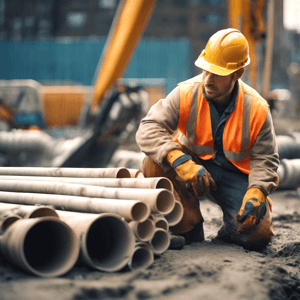Underground drainage Method Statement

This method statement for installing underground drainage is available as an instant download.
It has a section at the top of the first page for you to enter your company name and project details and a section at the bottom for you to sign, print and date.
It couldn’t be easier. Once you’ve entered your details, you’re good to go.
You make the document specific to you and your needs by inserting your company name, logo, contract details, site address etc…
The method statement becomes part of your branded H&S package.
Underground drainage systems comprise a network of pipes and fittings installed beneath the soil surface to efficiently transport wastewater and surface water away from properties. These systems play a crucial role in modern construction and landscaping, helping to prevent water damage while ensuring proper hygiene and sanitation.
The primary purpose of underground drainage systems is to collect and direct various liquids, such as rainwater, sewage, and greywater, thereby reducing the risks of flooding and soil erosion. These systems are engineered to efficiently redirect excess water, which contributes to the stability of the landscape and the structural integrity of buildings.
Typically, an underground drainage system comprises several components, including pipes made from materials such as PVC (polyvinyl chloride) or clay, manholes for access and maintenance, and catch basins that filter out debris and sediment from the water. The pipes are typically installed in trenches, often accompanied by a layer of gravel that facilitates effective drainage.
Wastewater from residential or commercial buildings flows into this network of drainage through interconnected pipes, ultimately leading to a sewage treatment facility or a soakaway pit where the waste can be processed or absorbed into the ground.
Implementing an underground drainage system is essential for protecting properties from water-related damage. By managing excess water, these systems help keep surrounding areas dry, which is vital for maintaining healthy vegetation and preventing issues such as waterlogging.
To ensure continued functionality, it's important to conduct regular inspections and cleanings of the drainage system. This proactive approach allows for the identification of potential blockages, ensuring that the system operates efficiently and safeguards properties against water-related challenges. In summary, well-designed and properly maintained underground drainage systems are critical for effective water management in both urban and rural environments.
The method statement is:
- Recognised by local authorities
- Recognised by principal contractors
- Suitable for CDM sites
- Approved by H&S managers
It increases your chance of winning tenders and has been written by trained health and safety professionals.
If the method statement needs altering to include an additional task, such as:
“Ensure you sign and date the site register located in the welfare facilities before commencing work”
It can easily be added as the document comes in Word™, not PDF.
Once you buy and download this document, it’s yours for life to use repeatedly.
We’ve done the hard work for you, allowing you to inspire confidence in your company, products, and services.
The scope of works that this method statement covers includes:
- Start of works
- Install underground drainage with an inspection chamber.
- Finishing
Why not browse the HSEDocs catalogue of method statements, risk assessments, COSHH assessments, or industry-specific packages?
And for safety training relevant to your job, visit our online training courses.
GET THIS DOCUMENT
£8.99+VAT
- Available in Word™
- Fully customisable
- Add your Company Logo
- UK & EU Compliant

 CART
CART 